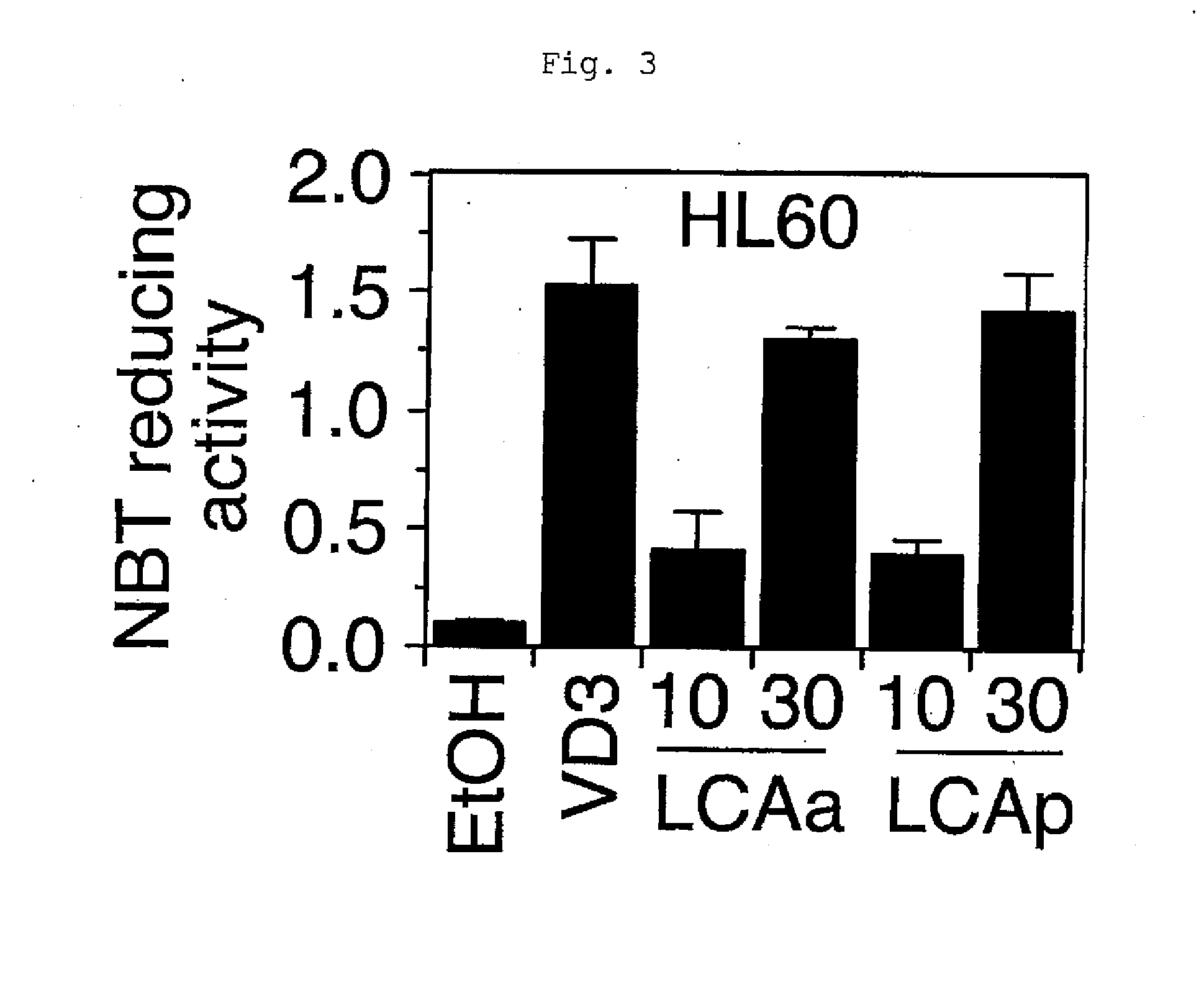Function-Selective Vitamin D Receptor Agonist
a function-selective, vitamin d receptor technology, applied in the direction of antibacterial agents, immunological disorders, drug compositions, etc., can solve the problem that the effect of elevating blood calcium levels is difficult to be separated from other vdr-mediated actions, and the adverse drug reaction is difficult to achiev
- Summary
- Abstract
- Description
- Claims
- Application Information
AI Technical Summary
Benefits of technology
Problems solved by technology
Method used
Image
Examples
example 1
[0035]
[0036]A THF (4 mL) solution of lithocholic acid (376 mg, 1 mmol) and propionic anhydride (1.3 mL) was cooled to 0° C., BF3.Et2O (32 μL, 0.25 mmol) was added thereto, and the mixture was heated under reflux for 15 hours. A saturated NaHCO3 aqueous solution was added to the reaction mixture, which was then stirred at room temperature for 1 hour. The reaction mixture was extracted with ethyl acetate, the extract was washed with a saline solution, and dried with anhydrous MgSO4 to evaporate the solvent. The residue was purified by column chromatography (SiO2, 15 g, 15% ethyl acetate / hexane) to yield a propionate ester (346 mg, 80%). The ester was recrystallized with benzene / hexane to give a colorless crystal.
[0037]mp 152-153° C.
[0038]1H NMR (δ) 0.64 (3H, s, H-18), 0.926 (3H, s, H-19), 0.92 (3H, d, J=5.5 Hz, H-21), 1.13 (3H, t, J=7.5 Hz, CH3CH2CO—), 2.27-2.36 (3H, m, H-23 & CH3CH2CO—), 2.36-2.44 (1H, m, H-23), 4.73 (1H, m, H-3).
[0039]13C NMR (d) 9.2, 12.0, 18.2, 20.8, 23.3, 24.1, 2...
example 2
[0041]In accordance with the methods described in the literature (Science Vol. 284, 1999, pp. 1362-1365; Science Vol. 296, 2002, pp. 1313-1316), lithocholic acid propionate was examined for the VDR activation potency. A CMX-GAL4-VDR expression vector (the CMX-GAL4-mRXRγ vector and CMX-hVDR vector donated by Professor Kazuhiko Umezono (deceased), Institute for Virus Research, Kyoto University were so processed as to replace the mRXRγ fragment with the corresponding hVDR ligand-binding region) and an MH100(UAS)×4-tk-LUC reporter vector (donated by Professor Kazuhiko Umezono (deceased), Institute for Virus Research, Kyoto University) were transfected in human embryonic kidney-derived HEK293 cells (obtained from an independent administrative institution, RIKEN BioResource Center) by the calcium phosphate coprecipitation assay. Eight hours after transfection, lithocholic acid propionate (prepared in Example 1) was added to the culture medium. Cells were solubilized 16 to 18 hours later, ...
example 3
[0042]Lithocholic acid propionate was injected into animals to examine the plasma calcium level and the effect of inducing the expression of a VDR target gene in an organ. Male mice between 8 and 9 weeks of age (C57BL / 6J, Charles River Laboratories Japan) were injected intraperitoneally with the compound dissolved in phosphate buffered saline every other day. On day 8, the plasma and the organ were collected. Plasma calcium was quantified by the o-cresolphthalein complexone method, and the expression of the VDR target gene CYP24 in kidney was assayed by the method described in the literature (J Lipid Res Vol. 46, 2005, pp. 46-57). Lithocholic acid propionate and lithocholic acid acetate induced the expression of the VDR target gene in the organ. The effect on the plasma calcium level was compared among 1α-hydroxyvitamin D3, lithocholic acid propionate, and lithocholic acid acetate at concentrations which induced the kidney CYP24 gene expression to the same extent. 1α-Hydroxyvitamin ...
PUM
 Login to View More
Login to View More Abstract
Description
Claims
Application Information
 Login to View More
Login to View More - R&D
- Intellectual Property
- Life Sciences
- Materials
- Tech Scout
- Unparalleled Data Quality
- Higher Quality Content
- 60% Fewer Hallucinations
Browse by: Latest US Patents, China's latest patents, Technical Efficacy Thesaurus, Application Domain, Technology Topic, Popular Technical Reports.
© 2025 PatSnap. All rights reserved.Legal|Privacy policy|Modern Slavery Act Transparency Statement|Sitemap|About US| Contact US: help@patsnap.com



